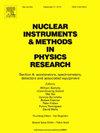中国科学院FAMU实验的快速x射线探测器系统
IF 1.5
3区 物理与天体物理
Q3 INSTRUMENTS & INSTRUMENTATION
Nuclear Instruments & Methods in Physics Research Section A-accelerators Spectrometers Detectors and Associated Equipment
Pub Date : 2025-06-27
DOI:10.1016/j.nima.2025.170780
引用次数: 0
摘要
RAL的FAMU实验设计用于研究介子氢的超精细分裂(HFS),从而测量质子的泽马赫半径,精度优于1%。HFS跃迁由可调谐的MIR激光器在~ 6790nm激发,并通过延迟(μO) x射线发射在130-170 keV左右识别。快速x射线探测系统是基于34个闪烁的LaBr3:Ce晶体和一个用于内部校准的HPGe探测器。本文章由计算机程序翻译,如有差异,请以英文原文为准。
The fast X-ray detector system of the FAMU experiment at RAL
The FAMU experiment at RAL has been designed to study the hyperfine splitting (HFS) of muonic hydrogen and thus measure the Zemach radius of the proton, with a precision better than 1%. The HFS transition is excited by a tunable MIR laser at and is recognized by delayed (O) X-ray emission around 130–170 keV. The fast X-ray detection system is based on 34 scintillating LaBr:Ce crystals and one HPGe detector for inter-calibration.
求助全文
通过发布文献求助,成功后即可免费获取论文全文。
去求助
来源期刊
CiteScore
3.20
自引率
21.40%
发文量
787
审稿时长
1 months
期刊介绍:
Section A of Nuclear Instruments and Methods in Physics Research publishes papers on design, manufacturing and performance of scientific instruments with an emphasis on large scale facilities. This includes the development of particle accelerators, ion sources, beam transport systems and target arrangements as well as the use of secondary phenomena such as synchrotron radiation and free electron lasers. It also includes all types of instrumentation for the detection and spectrometry of radiations from high energy processes and nuclear decays, as well as instrumentation for experiments at nuclear reactors. Specialized electronics for nuclear and other types of spectrometry as well as computerization of measurements and control systems in this area also find their place in the A section.
Theoretical as well as experimental papers are accepted.

 求助内容:
求助内容: 应助结果提醒方式:
应助结果提醒方式:


